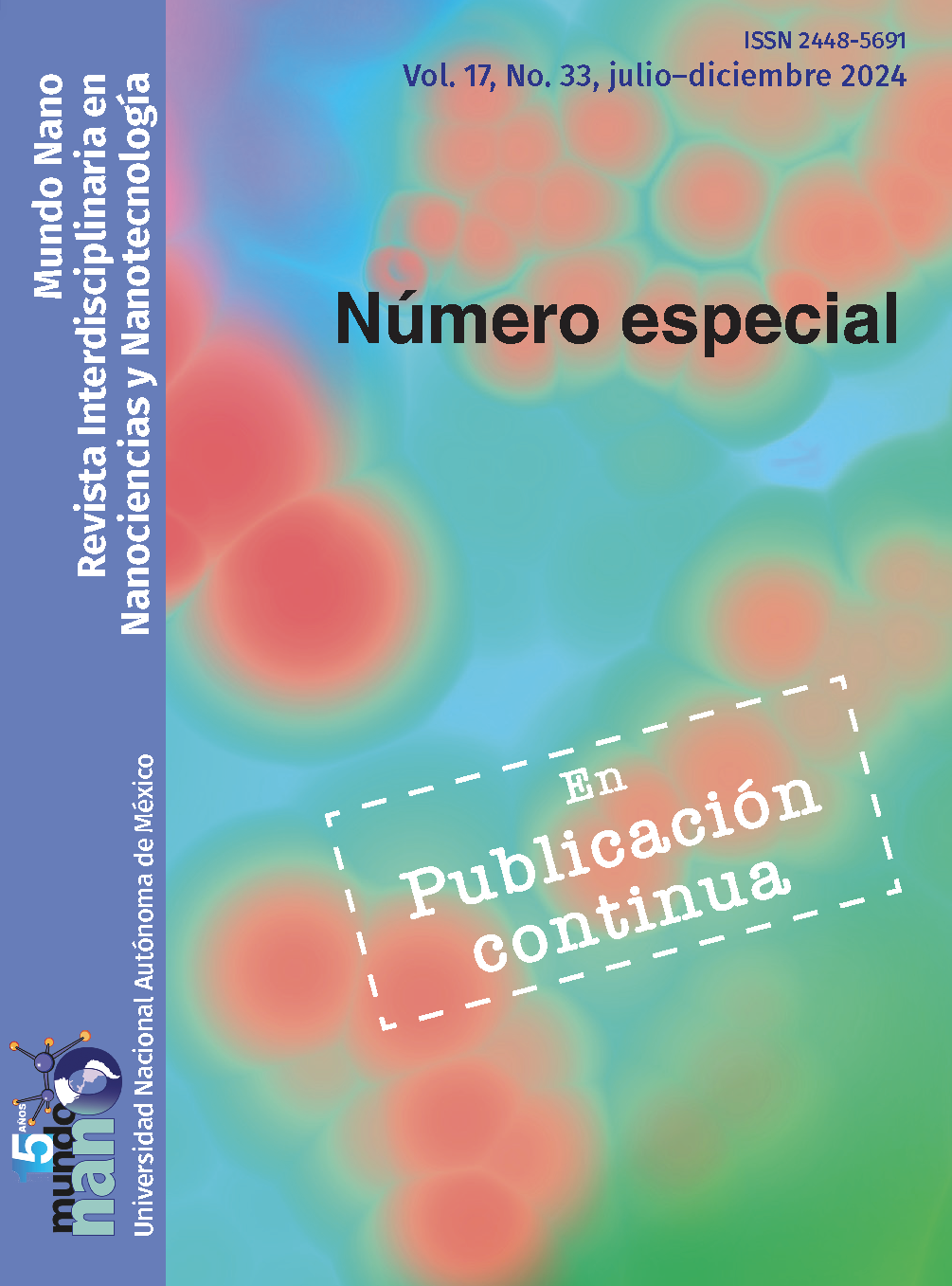Reconocimiento de nanomateriales por el sistema inmunológico
Contenido principal del artículo
Resumen
Los nanomateriales se encuentran presentes en muchos aspectos de la cotidianidad humana. En la escala nanométrica las propiedades de la materia se tornan complejas de analizar y sus efectos difíciles de predecir. Por esto, gran parte de la comunidad científica se ha enfocado en el estudio exhaustivo de sus interacciones con los organismos biológicos, particularmente con el sistema inmunológico, pues es la primera línea de defensa de los seres vivos. Los factores determinantes en la interacción del sistema inmunológico con los nanomateriales son las propiedades fisicoquímicas de estos últimos. A partir de estas interacciones pueden desencadenarse mecanismos de nanoinmunotoxicidad y las reacciones involucradas en los mismos pueden emplearse en técnicas de inmunoterapia para contribuir en la solución de problemas de salud pública. En esta revisión se recopilan algunos de los hallazgos más importantes hasta la fecha acerca de las respuestas inmunológicas provocadas por la exposición a nanomateriales.
Descargas
Detalles del artículo

Mundo Nano. Revista Interdisciplinaria en Nanociencias y Nanotecnología, editada por la Universidad Nacional Autónoma de México, se distribuye bajo una Licencia Creative Commons Atribución-NoComercial 4.0 Internacional.
Basada en una obra en http://www.mundonano.unam.mx.
Citas
Boraschi, D., Castellano, L. R. C. e Italiani, P. (2017). Interaction of nanomaterials with the immune system: role in nanosafety and nanomedicine. (Editorial). Frontiers in Immunology, 8: 28, noviembre. https://doi.org/10.3389/fimmu.2017.01688. DOI: https://doi.org/10.3389/fimmu.2017.01688
Boraschi, D., Italiani, P., Palomba, R., Decuzzi, P., Duschl, A., Fadeel, B. y Moghimi, S. M. (2017). Nanoparticles and innate immunity: new perspectives on host defence. Seminars in Immunology, 34: 33-51. https://doi.org/10.1016/j.smim.2017.08.013. DOI: https://doi.org/10.1016/j.smim.2017.08.013
Boraschi, D., Moein Moghimi, S. y Duschl, A. (2016). Interaction between the immune system and nanomaterials: safety and medical exploitation. (Editorial). Current Bionanotechnology, 2(1): 3-5. https://doi.org/10.2174/221352940201160718174904. DOI: https://doi.org/10.2174/221352940201160718174904
Camacho, Á. y Zapata, M. (2017). ¿Qué es un nanomaterial? https://biblat.unam.mx/es/revista/momento/articulo/que-es-un-nanomaterial. (Consultado, mayo 11, 2021).
Casals, E. Pfaller, T., Duschl, A., Oostingh, G. J. y Puntes, V. (2020). Time evolution of the nanoparticle protein corona. ACs. Nano, 4(7): 3623-3632. https://doi.org/10.1021/nn901372t. DOI: https://doi.org/10.1021/nn901372t
Comisión Europea. (2010). Scientific basis for the definition of the term “nanomaterial”. http://ec.europa.eu/health/scientific_committees/emerging/docs/scenihr_o_032.pdf.
Dwivedi, P. D., Misra, A., Shanker, R. y Das, M. (2009). Are nanomaterials a threat to the immune system? Nanotoxicology, 3(1): 19-26. https://doi.org/10.1080/17435390802604276. DOI: https://doi.org/10.1080/17435390802604276
Fadeel, B. (2012). Clear and present danger? Engineered nanoparticles and the immune system. Swiss Medical Weekly, 142, jun. https://doi.org/10.4414/smw.2012.13609. DOI: https://doi.org/10.4414/smw.2012.13609
Fadeel, B. (2019). Hide and seek: nanomaterial interactions with the immune system. Frontiers in Immunology, 10: 133, febrero. https://doi.org/10.3389/fimmu.2019.00133. DOI: https://doi.org/10.3389/fimmu.2019.00133
Farrera, C. y Fadeel, B. (2015). It takes two to tango: understanding the interactions between engineered nanomaterials and the immune system. European Journal of Pharmaceutics and Biopharmaceutics, 95: 3-12. https://doi.org/10.1016/j.ejpb.2015.03.007. DOI: https://doi.org/10.1016/j.ejpb.2015.03.007
García, C. P., Sumbayev, V., Gilliland, D., Yasinska, I. M., Gibbs, B. F., Mehn, D., Rossi, F. (2013). Microscopic analysis of the interaction of gold nanoparticles with cells of the innate immune system. Scientific Reports, 3(1): 1326. https://doi.org/10.1038/srep01326. DOI: https://doi.org/10.1038/srep01326
Gbadamosi, J. K., Hunter, A. C. y Moghimi, S. M. (2002). PEGylation of microspheres generates a heterogeneous population of particles with differential surface characteristics and biological performance. FEBS Letters, 532(3): 338-344. https://doi.org/10.1016/S0014-5793 (02)03710-9. DOI: https://doi.org/10.1016/S0014-5793(02)03710-9
Ghafari, J., Moghadasi, N. y Omari Shekaftik, S. (2020). Oxidative stress induced by occupational exposure to nanomaterials: a systematic review. Industrial Health, 58(6): 492-502. https://doi.org/10.2486/indhealth.2020-0073. DOI: https://doi.org/10.2486/indhealth.2020-0073
Hulander, M., Lundgren, A., Berglin, M., Ohrlander, M., Lausmaa, J. y Elwing, H. (2011). Immune complement activation is attenuated by surface nanotopography. International Journal of Nanomedicine, 6: 2653-2666. https://doi.org/10.2147/IJN.S24578. DOI: https://doi.org/10.2147/IJN.S24578
Hussain, S., Vanoirbeek, J. A. J. y Hoet, P. H. M. (2012). Interactions of nanomaterials with the immune system. WIREs Nanomedicine and Nanobiotechnology, 4(2): 169-183. https://doi.org/10.1002/wnan.166. DOI: https://doi.org/10.1002/wnan.166
Liu, J., Feng, X., Wei, L., Chen, L., Song, B. y Shao, L. (2016). The toxicology of ion-shedding zinc oxide nanoparticles. Critical Reviews in Toxicology, 46(4): 348-384. https://doi.org/10.3109/10408444.2015.1137864. DOI: https://doi.org/10.3109/10408444.2015.1137864
Liu, X., Xie, X., Jiang, J., Lin, M., Zheng, E., Qiu, W., …, Meng, H. (2021). Use of nanoformulation to target macrophages for disease treatment. Advanced Functional Materials, 2104487. https://doi.org/10.1002/ADFM.202104487. DOI: https://doi.org/10.1002/adfm.202104487
Liu, Yuan, Yin, Y., Wang, L., Zhang, W., Chen, X., Yang X., …, Ma, G. (2013). Surface hydrophobicity of microparticles modulates adjuvanticity. Journal of Materials Chemistry B, 1(32): 3888-3896. https://doi.org/10.1039/c3tb20383b. DOI: https://doi.org/10.1039/c3tb20383b
Liu, Yuanchang, Hardie, J., Zhang, X. y Rotello, V. M. (2017). Effects of engineered nanoparticles on the innate immune system. Seminars in Immunology, 34: 25-32. https://doi.org/10.1016/j.smim.2017.09.011. DOI: https://doi.org/10.1016/j.smim.2017.09.011
Pallardy, M. J., Turbica, I. y Biola-Vidamment, A. (2017). Why the immune system should be concerned by nanomaterials? Frontiers in Immunology, 8, mayo. https://doi.org/10.3389/fimmu.2017.00544. DOI: https://doi.org/10.3389/fimmu.2017.00544
Rezaei, R., Safaei, M., Mozaffari, H. R., Moradpoor, H., Karami, S., Golshah, A., …, Karami, H. (2019). The role of nanomaterials in the treatment of diseases and their effects on the immune system. Open Access Macedonian Journal of Medical Sciences, 7(11): 1884-1890. https://doi.org/10.3889/oamjms.2019.486. DOI: https://doi.org/10.3889/oamjms.2019.486
Shannahan, J. H., Podila, R., Aldossari, A. A., Emerson, H., Powell, B. A., Ke, P. C., Rao, A. M. y Brown, J. M. (2015). Formation of a protein corona on silver nanoparticles mediates cellular toxicity via scavenger receptors. Toxicological Sciences, 143(1): 136-146. https://doi.org/10.1093/toxsci/kfu217. DOI: https://doi.org/10.1093/toxsci/kfu217
Smith, M. J., Brown, J. M., Zamboni, W. C. y Walker, N. J. (2014). From immunotoxicity to nanotherapy: the effects of nanomaterials on the immune system. Toxicological Sciences, 138(2): 249-255. https://doi.org/10.1093/toxsci/kfu005. DOI: https://doi.org/10.1093/toxsci/kfu005
Sohaebuddin, S. K., Thevenot, P. T., Baker, D., Eaton, J. W. y Tang, L. (2010). Nanomaterial cytotoxicity is composition, size, and cell type dependent. Particle and Fibre Toxicology, 7. https://doi.org/10.1186/1743-8977-7-22. DOI: https://doi.org/10.1186/1743-8977-7-22
Szakal, C., Tsytsikova, L., Carlander, D. y Duncan, T. V. (2014). Measurement methods for the oral uptake of engineered nanomaterials from human dietary sources: summary and outlook. Comprehensive Reviews in Food Science and Food Safety, 13: 669-678, 1 de julio. https://doi.org/10.1111/1541-4337.12080. DOI: https://doi.org/10.1111/1541-4337.12080
Yan, Y., Gause, K. T., Kamphuis, M. M. J., Ang, C.-S., O’Brien-Simpson, N. M., Lenzo, J. C., Reynolds, E. C., Nice, E. C. y Caruso, F. (2013). Differential roles of the protein corona in the cellular uptake of nanoporous polymer particles by monocyte and macrophage cell lines. ACS Nano, 7(12): 10960-10970. https://doi.org/10.1021/nn404481f. DOI: https://doi.org/10.1021/nn404481f





